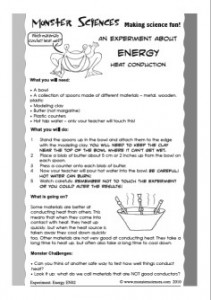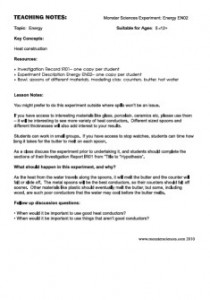Different things conduct heat in different ways. Use this energy science experiment to test which things conduct heat the best.
 |
 |
What you will need:
- A bowl
- A collection of spoons made of different materials – metal, wooden, plastic
- Modeling clay
- Butter (not margarine)
- Plastic counters
- Hot tap water – only your teacher will touch this!
What you will do:
- Stand the spoons up in the bowl and attach them to the edge with the modeling clay. You will need to keep the clay near the top of the bowl where it can’t get wet.
- Place a blob of butter about 5 cm or 2 inches up from the bowl on each spoon.
- Press a counter onto each blob of butter.
- Now your teacher will pour hot water into the bowl. Be careful! Hot water can burn!
- Watch carefully. Remember not to touch the experiment or you could alter the results!
What is going on?
Some materials are better at conducting heat than others. This means that when they come into contact with heat, they heat up quickly, but when the heat source is taken away they cool down quickly too. Other materials are not very good at conducting heat. They take a long time to heat up, but often also take a long time to cool down.
Monster Challenges:
- Can you think of another safe way to test how well things conduct heat?
- Look it up: what do we call materials that are NOT good conductors?
Teaching Notes:
Topic:
Energy
Key Concepts:
Heat conduction
Resources:
- Investigation Record IR01– one copy per student
- Experiment Description Energy EN02– one copy per student
- Bowl, spoons of different materials, modeling clay, counters, butter, hot water
Lesson Notes:
You might prefer to do this experiment outside where spills won’t be an issue.
If you have access to interesting materials like glass, porcelain, ceramics etc, please use them – it will be interesting to see more variety of heat conductors. Different sized spoons and different thicknesses will also add interest to your results.
Students can work in small groups. If you have access to stop watches, students can time how long it takes for the butter to melt on each spoon.
As a class discuss the experiment prior to undertaking it, and students should complete the sections of their Investigation Report IR01 from ”Title to “Hypothesis”.
What should happen in this experiment, and why?
As the heat from the water travels along the spoons, it will melt the butter and the counter will fall or slide off. The metal spoons will be the best conductors, so their counters should fall off sooner. Other materials like plastic should eventually melt the butter, but some, including wood, are such poor conductors that the water may cool before the butter melts.
Follow up discussion questions:
- When would it be important to use good heat conductors?
- When would it be important to use things that aren’t good conductors?



